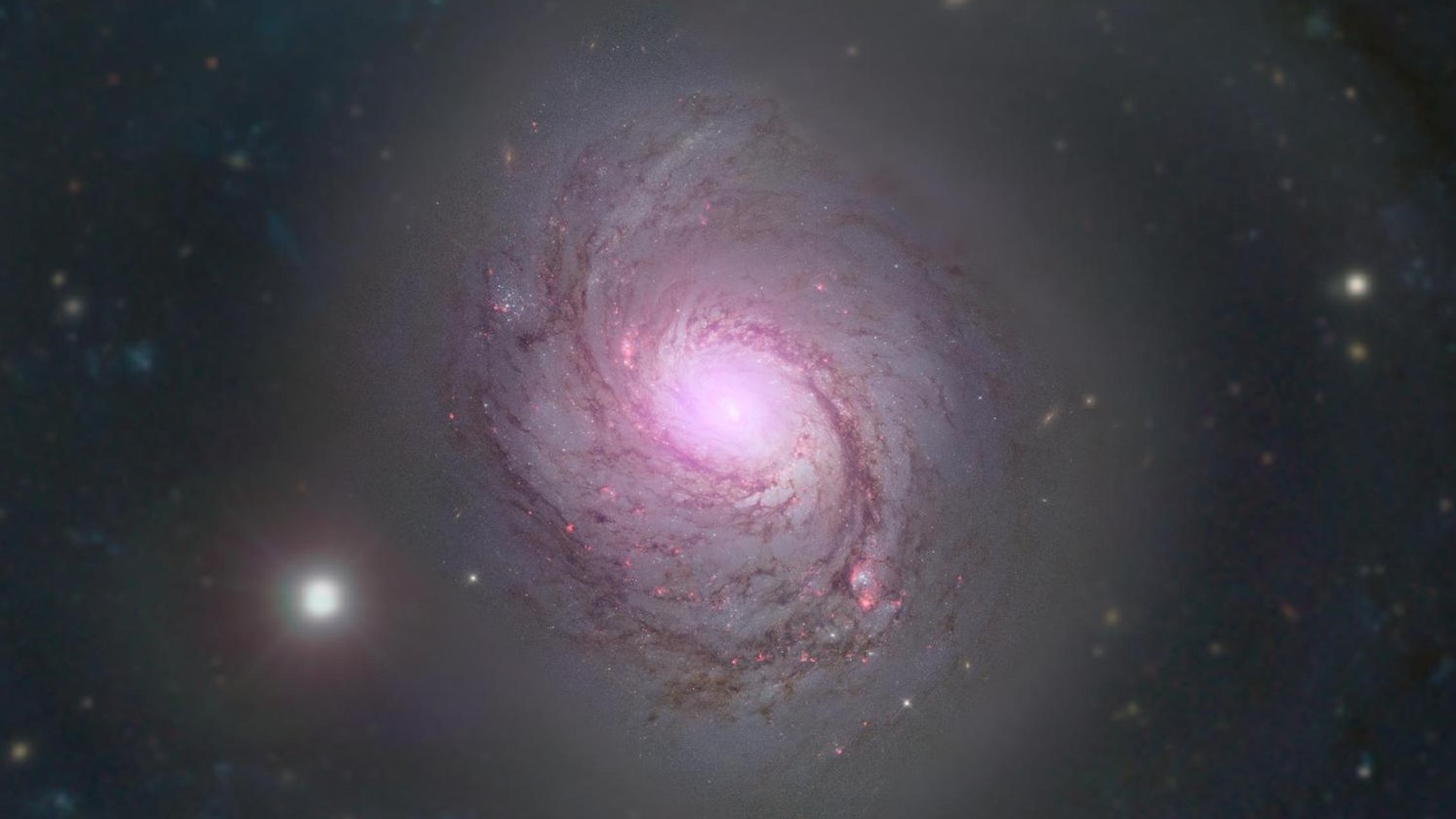Ghostly neutrino particles are blasting out of a nearby galaxy, and scientists aren't sure why
The spiral galaxy NGC 1068, also known as the squid galaxy, is a bustling 'Disneyland' of neutrino production, researchers said.

A nearby spiral galaxy is pumping out ghostly neutrinos — mysterious particles that barely interact with the matter around them, scientists have found.
The elusive particles are coming from a hotspot of neutrino production in the heart of the spiral galaxy Messier 77, which is anchored by a black hole. The region is rich in dense gas and electromagnetic fields, study leader Francis Halzen, a professor of physics at the University of Wisconsin–Madison, told Live Science. This makes it a "Disneyland for producing neutrinos," he said.
Increasingly, Halzen said, research is pointing to similar active galactic cores as places where neutrinos are born.
"That's what makes the paper exciting," he said of the new research, published Nov. 4 in the journal Science. "Not just to find another source, but it begins to point at what may be the accelerator of cosmic rays and the sources of the neutrinos."
Neutrino hunt
Neutrinos are subatomic particles with no charge and almost no mass. They interact with only two forces, gravity and the weak force, which is responsible for some types of radioactive decay. They travel at almost the speed of light and are enormously abundant — about 100 billion pass through every square centimeter of your body every second . However, they are extremely hard to detect because they interact so weakly with matter.
Neutrinos can be created just about anywhere in the universe — from decaying elements within Earth to gargantuan supernova explosions on the other side of the cosmos. For decades, scientists have worked to understand the myriad forces that create the mysterious particles.

To detect neutrinos, particularly the high-energy neutrinos produced in cosmic rays from galactic sources, researchers have had to get extremely creative. Their solution is the IceCube Neutrino Observatory, an array of more than 5,000 sensors frozen into 0.2 cubic mile (1 cubic kilometer) of Antarctic ice. When a neutrino crashes into a proton or neutron in the nucleus of an atom, it creates new particles that give off blue bursts of light known as Cherenkov radiation. IceCube detects this Cherenkov radiation to discover neutrinos. The ice shields the sensors from cosmic radiation and provides a stable, transparent medium in which to "see" the zinging neutrinos.
Sign up for the Live Science daily newsletter now
Get the world’s most fascinating discoveries delivered straight to your inbox.
Neutrinos travel in a straight line, so it's also possible to use IceCube to discover where the neutrinos came from. In the new study, Halzen and his team did a scan of the entire sky, looking for "hotspots" from which higher-than-usual concentrations of neutrinos seemed to emanate.
Messier 77 popped out.
A galactic hotspot
Messier 77, also known as NGC 1068, or the "squid galaxy," is about 47 million light-years away from Earth and can be seen from our planet with a pair of binoculars or a backyard telescope. Earlier this year, another group of researchers discovered a supermassive black hole at the center of Messier 77, but thick masses of dust obscure the view. The newly discovered neutrinos could provide a window into the galaxy's heart.
The IceCube team first reported a source of high-energy neutrinos in 2018, coming from another active galactic core anchored by a massive black hole. That neutrino factory sits on the shoulder of the constellation Orion.
Initially, Halzen said, scientists thought that these neutrinos were produced in enormous jets that shoot out from the massive black hole. But the physics of such a jet are not actually ideal for producing neutrinos, Halzen said. And Messier 77's black hole does not produce these jets, suggesting that the neutrinos form on the border of the black hole itself. This area is called the accretion disc, and it's full of matter pulled in by the black hole's gravitational field.
"Above and below the accretion disk there are very high magnetic fields, so you already can produce neutrinos there," Halzen said. "Then when the material falls into the black hole, close to the black hole, there's another opportunity to produce neutrinos."
The study could not determine exactly how these neutrinos are produced, but previous research from IceCube suggests that active galactic cores like the one at the heart of Messier 77 accelerate streams of radiation known as cosmic rays to high-energy states. When the protons from these cosmic rays hit the nuclei of atoms, they create a shower of secondary particles, some of which decay into neutrinos.
The researchers made multiple improvements to the IceCube detector and their analysis techniques to detect NGC 1068, Halzen said, and the team plans to continue these efforts — especially as they paid off so richly in finding the new neutrino hotspot.
"There will be more," Halzen said.

Stephanie Pappas is a contributing writer for Live Science, covering topics ranging from geoscience to archaeology to the human brain and behavior. She was previously a senior writer for Live Science but is now a freelancer based in Denver, Colorado, and regularly contributes to Scientific American and The Monitor, the monthly magazine of the American Psychological Association. Stephanie received a bachelor's degree in psychology from the University of South Carolina and a graduate certificate in science communication from the University of California, Santa Cruz.










